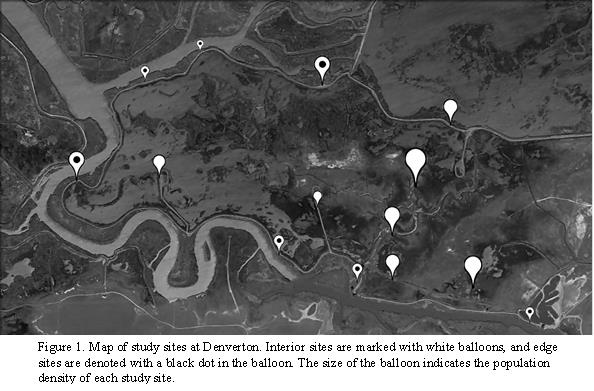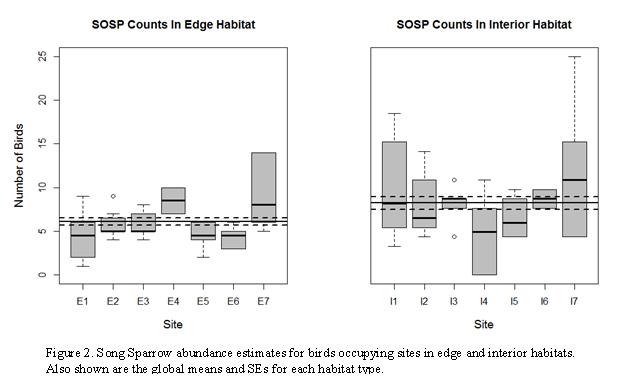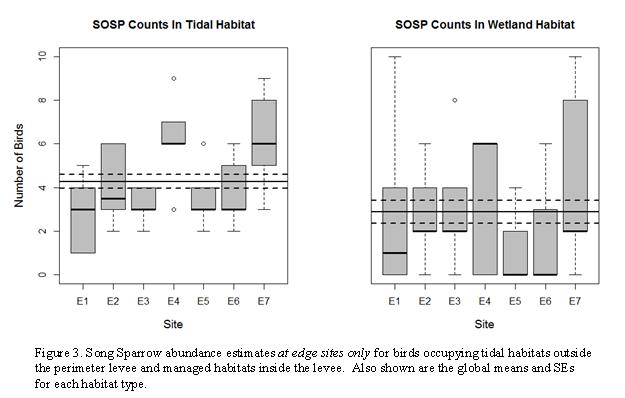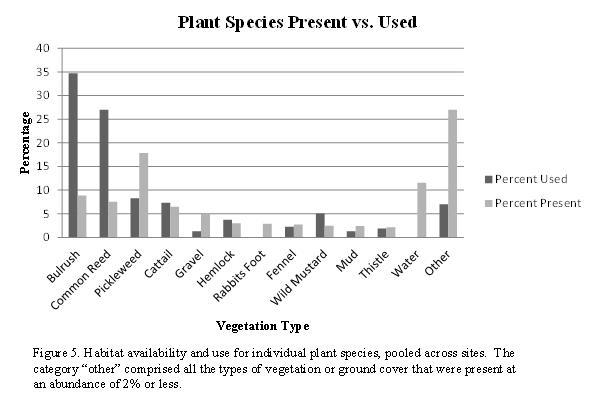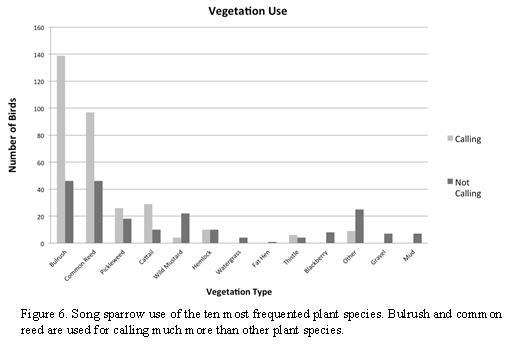By Debi Fanucchi, Oscar Garzon, Julia F. Herring, and Kevin M. Ringelman
ABSTRACT
The Suisun Song Sparrow (Melospiza melodia maxillaris) is a subspecies of Song Sparrow that is endemic to the Suisun Marsh of California. It is listed as a state species of special concern by the California Department of Fish and Wildlife due to its restricted range, small breeding population, and susceptibility to encroaching human development. The Suisun Marsh ecosystem is highly altered, and is comprised of both natural tidal wetlands and impounded wetlands that are cut off from the natural tidal cycle. Suisun Song Sparrows are believed to prefer natural tidal wetlands, but there is a lack of information on sparrow densities and habitat associations in impounded wetlands. To address this knowledge gap, we examined the abundance and habitat preferences of Suisun Song Sparrows in an impounded and heavily managed wetland complex. We conducted surveys at seven sites within interior managed (impounded) wetlands, and seven sites along edges between tidal and impounded wetlands. We found significantly more birds in interior sites than at edge sites, but within edge habitat, abundances were higher on the tidal side of the levee. We found that Song Sparrows used tall vegetation in greater proportion than its abundance, and specifically preferred bulrush and common reed as calling perches. Interior sites contained relatively less of this preferred vegetation than edge sites, suggesting that beneficial habitat heterogeneity in interior sites, and/or deleterious edge effects along the dikes may be important drivers of abundance. In the face of sea-level rise and shifting conservation priorities, many managed wetlands are expected to be converted back into fully tidal systems, and our results provide an important baseline for future research on the effects of tidal restoration.
The Suisun Marsh of California (38° 10’ N, 122°, 0’ W) is the largest estuarine marsh on the west coast of North America, and comprises more than 10% of California’s remaining natural wetlands (CA Dept. of Water Resources 2013). Located at the terminus of the Sacramento/San Joaquin River Delta, Suisun Marsh is 116,000 hectares in size, nearly half of which is privately owned and managed for waterfowl hunting habitat (CA Dept. of Water Resources 2013). Suisun Marsh is a critical stopover and wintering site for tens of thousands of waterfowl migrating through the Pacific Flyway, and provides habitat for over 221 bird species, 45 mammal species, 16 reptile and amphibian species, and more than 40 fish species (Moyle et al. 2014). Several of these are of conservation concern, including the endangered Delta Smelt (Hypomesus transpacificus), endangered California Clapper Rail (Rallus longirostris obsoletus), and a state species of special concern, the Suisun Song Sparrow (Melospiza melodia maxillaris), an endemic subspecies of Song Sparrow that is entirely restricted to wetlands surrounding Suisun Bay.
The Suisun Song Sparrow shares genetic similarities with the Alameda Song Sparrow (Melospiza melodia pusillula) and Samuel’s Song Sparrow (Melospiza melodia samuelis); however, these subspecies have non-overlapping ranges, occupy distinct habitats, and do not interbreed (Nur et al. 1997). The range of the Suisun Song Sparrow is limited to wetlands surrounding Suisun Bay, beginning at the junction of the Sacramento and San Joaquin rivers in the east and extending west only as far as the Carquinez Straits (Humple and Geupel 2004). Due to its restricted range, small breeding population, and susceptibility to encroaching human development, the Suisun Song Sparrow is formally listed as a species of special concern by the California Department of Fish and Game (CDFG 2001).
Suisun Song Sparrows are believed to prefer fully tidal marsh to muted tidal marsh (where natural tidal regimes are altered by dikes and water control structures) or impounded wetlands; in fully tidal marsh, nests have been documented at only 10-50 meters apart (Nur and Spautz 2002, Shuford and Gardali 2008). These fully tidal areas are dominated by homogeneous patches of tall vegetation, predominantly bulrush (Schoenoplectus lacustris) and cattail (Typha latifolia). Bulrush provides cover from predators and perches to call from, while cattail provides the seeds that make up the majority of their diet (LSA Associates 2009). Additionally, tidal cycles expose mudflats on which Suisun Song Sparrows forage for seeds (primarily from bulrush and cattail) and invertebrates (Marshall 1948).
The Suisun Song Sparrow is of conservation concern because its native tidal habitat has been in decline for centuries. Gold mining in the 1800s flushed large amounts of sediment from the mountains, clogging marsh channels and drastically altering natural flow regimes (Moyle et al. 2014). The early decades of the 1900s saw vast sections of the marsh diked and leveed to create waterfowl hunting clubs, as well as the establishment of a railroad to convey wealthy hunters from San Francisco into the marsh interior (Moyle et al. 2014). The loss of natural tidal habitat has undoubtedly contributed to a decline in Suisun Song Sparrow populations, from an estimated ~300,000 birds in the 1800s (Grinnell and Miller 1944, Nur and Spautz 2002) to ~50,000 today (Shuford et al. 2008). In its current form, the marsh is a highly modified ecosystem with only 5.4% remaining as “pristine” tidal marsh (CA Dept of Water Resources 2013); much of the remainder is divided among the 158 duck clubs currently operating in the Suisun Marsh (CA Dept of Water Resources 2013), most of which independently manage their properties to grow seed plants (often non-native) to attract wintering waterfowl. This management strategy has resulted in extensive diking of Suisun Marsh in order to maintain the flooding regimes required by these plants. The Suisun Song Sparrow is anecdotally known to occupy managed duck clubs, although there have been no rigorous population assessments in these privately-held wetlands.
Given that duck clubs comprise over half of the Suisun Marsh, it is of critical importance to understand how threatened and declining species, such as the Suisun Song Sparrow, are using these highly modified habitats. This knowledge is all the more important given impending changes to the Marsh ecosystem—chief among them are sea-level rise and shifting conservation priorities. Sea level is predicted to rise by more than 1.5 m by 2100 (Vermeer and Rahmstorf 2009), which will alter tidal regimes and create new zones of tidal wetlands. Concurrently, concern for endangered fish species has prompted conservation biologists to call for extensive restoration of tidal habitat, most of which will be restored through converting managed duck clubs into natural tidal ecosystems. It is unclear how these landscape changes will impact Suisun Song Sparrow populations, primarily because so little is known about how these birds use impounded wetlands.
To address this knowledge gap, we studied abundances and habitat preferences of Suisun Song Sparrows inhabiting a managed duck club, with direct comparisons to an adjacent tidal levee. We predicted that the abundance of Suisun Song Sparrows in pristine tidal habitat would be significantly higher than the abundance of sparrows observed at sites within the interior of the managed wetlands. In addition, we hypothesized that the number of birds observed perching on tall vegetation will be significantly higher than the number of birds perching on medium or short vegetation, because tall vegetation may be used as calling perches. Knowing how birds are using managed marsh ecosystems may help us understand the effects that are likely to arise as these wetlands are converted back to tidal habitat. In fact, parts of our study site are slated for such a conversion within the next 5-10 years, making our study an important baseline assessment for this area, with broader applications to similar regions throughout Suisun Marsh.
METHODS
We conducted our study on a managed duck club owned by the California Waterfowl Association. The Denverton Duck Club property (38° 12’ 54” N, 121°, 54’ 54” W) is ~380 hectares in size, and is heavily managed as waterfowl hunting habitat. The property is fully diked-off from the tidal system: a 3-mile U-shaped perimeter levee separates the managed wetlands from the tidal wetlands which surround the property on three sides, and the flow regime is dictated by water-control structures. In the summer, interior managed wetlands are characterized by hypersaline soils, small pools of stagnant water, and highly variable types of vegetation, including tall reeds (Phragmites), mid-height vegetation such as mustard (Brassica spp.) and poison hemlock (Conium maculatum), short grasses such as rabbitsfoot grass (Polypogon monspeliensis) and saltgrass (Distichlis spicata), and low woody cover such as pickleweed (Salicornia virginica). The Denverton property lies within the distinctive range of the Suisun Song Sparrow (Shuford et al. 2008).
Our goal of this study was to compare Suisun Song Sparrow distributions between interior wetlands and habitat along the tidal levee; thus, our first step was to identify informative sampling areas. We selected seven sites in the interior of the managed wetland complex at least 100 m from the tidal levee, and seven sites along the perimeter levee that divides the managed wetlands from fully tidal habitat. These fourteen sampling locations were separated by 200 meters or more (Fig. 1), and were characterized by representative vegetation types, soil salinities, and water regimes.
We selected interior sites based on three criteria; vegetation height, vegetation heterogeneity, and accessibility. After exploring the interior managed wetlands on foot, we selected seven sites to represent the range of habitat available to Suisun Song Sparrows within the managed wetland. Five out of seven sites contained a heterogeneous mixture of vegetation species at a variety of heights, while two out of seven sites were dominated by one vegetation species (pickleweed) at a low height (this habitat type was extremely common at Denverton). Because the vegetation composition of edge habitat was similar throughout the property, and because accessibility was not an issue along the levee road, edge study sites were selected based solely on visibility and even spacing. Each site had at least 80 meter visibility on either side of the levee, and an attempt was made to select sites distributed evenly along the levee road in order to cover as much of our study area as possible.
We described habitat components at all study locations using two parameters: vegetation species (or cover type such as mud, water or gravel) and vegetation height. Each site was divided into four quadrants based on cardinal directions, beginning in the Northeast quadrant and continuing clockwise. We described the habitat in each quadrant, and also noted how sparrows were using different types of vegetation (e.g. calling, hiding). In addition, we estimated the percent cover of vegetation in each quadrant out to 50 meters from the center of the study site. We estimated percent cover of individual plant species, and we also aggregated vegetation data into five categories based on height: tall vegetation (greater than one meter), medium vegetation (.5- 1m), short vegetation (less than .5 m), bare ground (gravel and mud), and water.
At each of our fourteen sampling locations, we conducted daily standing point counts from 20 June 2013 to 26 June 2013 between the hours of 0530 and 0900 following standard point count protocols (Reynolds et al 1980, Scott and Ramsey 1981)(1). We selected stationary point count methods to reduce the effect of observer presence on bird behavior and to standardize the time spent at each location. During each point count, observers stood at a predetermined location and counted all Suisun Song Sparrows detected audibly or visually. We conducted our surveys at each point count station for a total of 10 minutes on a daily basis, but only recorded individual sparrows at an instant in time. This “snapshot” method (Buckland et al. 2001) was used to mitigate the possibility of counting the same bird more than once. After each initial observation, we tracked each bird for 60 seconds before the next snapshot in order to avoid counting the same bird twice. We used program Distance (Thomas et al 2009), to calculate population density, which accounts for biases in detection probability. To further increase our detection probability, we selected an 80 m observation radius (estimated using laser rangefinders) to ensure that observers could reliably locate and identify all birds (Reynolds et al 1980). Each time observers detected a sparrow, the type of detection was recorded as visual or auditory; thus, we included birds that were calling from within vegetation that we were not able to visually locate. We conducted surveys at each point count station for periods of 10 minutes to allow enough time to count as many birds as possible, yet avoiding the probability of having outside birds move into the study site (Fuller and Langslow 1984).
With the software Distance, we used the conventional distance sampling analysis engine, in which the only covariate in the detection function is distance. The inputs that we used for this analysis were study site, number of birds observed at that site, the number of times each site was surveyed, and the radial distance at which each bird was detected. All other analyses were conducted in R 2.13, and we report means ± standard errors unless otherwise noted.
RESULTS
To begin our analysis, we compared the number of birds occupying interior managed wetlands (core habitat well inside the levee) to the number of birds occupying edge habitat (either inside or outside the levee) (Fig. 2). We counted significantly more birds in the interior managed wetlands (8.6 ± 0.7) than in edge habitat (6.1 ± 0.4) (Welch’s t-test, p = 0.01). These findings were supported by results we obtained using the program Distance to estimate the densities of Suisun Song Sparrows. Using Distance, we estimated densities to be 18.7 birds/hectare in the interior sites compared to only 10.8 birds/hectare on the edge sites, with a total abundance of ~390 birds in the Denverton Duck Club property. For our second analysis we focused only on the 7 edge sites, comparing the number of birds found inside the levee (managed wetland) to the number of birds found outside the levee (tidal wetland) (Fig. 3). Significantly more birds were counted outside the levee in tidal habitat (4.3 ± 0.3) compared to the number of birds counted inside the levee within managed wetland habitat (2.4 ± 0.3) (Welch’s t-test, p < 0.0001).
Using the vegetation data we collected, we analyzed how often birds used tall, medium and short vegetation in proportion to the abundance of each type across our study sites (Fig. 4). Tall vegetation made up only 36% of total ground cover, but was used by 83% of birds, indicating that tall plants are highly preferred by sparrows within our study sites. Medium height vegetation covered 14% of our sites, but was used by only 2% of birds. Short vegetation covered 28% and was used by 13% of birds.
Within these height categories of vegetation types, sparrows showed preferences for individual plant species. We observed birds using bulrush and common reed notably more frequently than any other plant species (Fig. 5). In proportion to their abundance, bulrush and common reed were used almost four times more often than they were found: while bulrush and common reed comprised only 9% and 8% of the total vegetation in our study sites, 35% of all birds were observed utilizing bulrush, and 27% of all birds were observed utilizing common reed. In contrast, pickleweed was twice as abundant as bulrush and cattail (covering 17% of all sites), yet it was used by only 8% of all sparrows observed.
In order to determine whether Suisun Song Sparrows show any preference in using specific types of vegetation as perches from which to call (which is important in mate attraction and territory maintenance), we analyzed the number of birds that used plants of different heights and noted whether each bird was actively calling or only perching. Our results show that tall plants, such as bulrush, cattail, and common reed, are heavily used by sparrows as vantage points from which to call; the majority of birds observed on these taller plant species were vocalizing (Fig. 6). We found that 75% of sparrows found on bulrush, 74% found on cattail, and 68% of birds found on common reed were using these plants as calling perches.
Our results suggest that Suisun Song Sparrows show a strong preference for tall vegetation. We counted more sparrows in interior habitat than edge habitat, but at edge sites, more birds were counted outside the levee in tidal marsh. To determine whether vegetation could be driving these differences in song sparrow abundance, we conducted two additional tests. Interestingly, we found that tall vegetation was more common at edge sites (42% of cover) than interior sites (33% of cover) (Welch’s t-test, p<0.003). The second analysis compared vegetation height in tidal marsh (outside the levee) to vegetation height in managed habitat (inside the levee).Within the edge sites, tall vegetation covered 50% of the tidal marsh side of the levee , but only 31% of the managed wetlands side (Welch’s t-test, p = 0.06).
DISCUSSION
The Suisun Marsh is a highly altered ecosystem that provides critical habitat to both wintering waterfowl and endemic species of conservation concern. Historically, these have been viewed as competing goals because waterfowl habitat is created by diking the marsh to create highly managed impoundments, which interrupts the natural tidal regimes that are important to endemic species. Sea-level rise and shifting conservation priorities will likely mandate that many waterfowl clubs be converted back to natural tidal systems in the coming decades; thus, understanding how species currently use these managed wetlands is critical to be able to predict the outcome of tidal restoration. In this study, we found significantly more birds in interior sites, despite the fact that edge sites generally had taller vegetation (which song sparrows prefer).
Because habitat heterogeneity is higher in interior sites, it is possible that the birds are utilizing the mixture of plant types and heights in the diked wetland for an array of activities, and thus prefer these interior sites. For example, we found that Suisun Song Sparrows prefer tall vegetation as perching sites while singing, yet pickleweed, which is low, is the third most used plant in the marsh after bulrush and common reed. Birds seen on shorter vegetation are less vocal, implying that birds use shorter plants for reasons other than vocal communication (e.g. refuge from predators, foraging). Furthermore, higher densities of birds in the interior habitat may be due to reduced edge effects in the core habitat. Birds in the interior may experience decreased disturbance from the levee road, decreased predation rates, and decreased exposure to intense weather such as high heat and wind (reviewed in Lahti 2001). Furthermore, the higher number of sparrows in the interior wetlands could be due to the shift of some breeding pairs from tidal habitat to diked wetlands late in the season in order to avoid flooding with the May and June high tides (Goals Project 2000, Johnston 1968).
When we considered only (non-preferred) edge sites, we observed more birds on the tidal side of the levee as compared to the managed wetland side of the levee, which is in accord with other studies on this species (Shuford 2008). On the edge, the vegetation in the tidal area was consistently taller than on the managed wetland, so we suggest that birds occupying the edge habitats prefer to be in the taller vegetation because it provides a better refuge from predation, wind, and human disturbance. This preference for tall vegetation could also be due to the presence of cattail and bulrush seeds, the Suisun Song Sparrow’s preferred food source (Marshall 1948). Additionally, because birds often call from the tall vegetation more common in tidal habitat, we may have been more likely to detect them. Conversely, the managed side of the levee has more short vegetation, mud and water. Birds tend to not use these cover types for calling, which presumably reduces their detectability.
Nur et al. (1997) showed that song sparrow densities were higher where there was more vegetation, but concluded that song sparrows do not use habitat in a selective manner. However, our results suggest that song sparrows use common reed, bulrush, and cattail in greater proportion than their availability. More generally, taller vegetation seems to be preferred, especially for perching and calling.
Overall, our study shows that Suisun Song Sparrows are relatively abundant in the interior of managed duck clubs compared to sites along a tidal levee. From a conservation perspective, this suggests that the interior of managed wetlands may be an important resource for the Suisun Song Sparrow, though it remains unclear whether managed wetlands are as attractive as pristine tidal habitat (Shuford et al. 2008)(2). Many duck clubs will persist in the coming decades, and will most likely be managed to benefit waterfowl; indeed, the San Francisco Bay Estuary provides winter habitat for 50% of most species of diving ducks utilizing the Pacific Flyway (Moyle et al. 2014). Thus, conservation biologists must find commonalities between the needs of migratory waterfowl and the needs of endemic species, such as the Suisun Song Sparrow. For example, both waterfowl and song sparrows benefit from exposed mudflats for foraging, and so managing for muted tidal flows in some areas may be beneficial to many species of birds (Larsen 1989). The Suisun Marsh ecosystem is likely to change dramatically in the next several decades: sea level rise will drown large areas of existing tidal marsh (Houghton et al. 2001, Orr et al. 2003) and many duck club levees will be breached to create new tidal marsh. Our results provide a baseline understanding of how Suisun Song Sparrows use managed wetlands, and set the stage for future studies examining the relative use of pristine tidal versus managed wetlands, and how these birds respond to tidal restoration.
ACKNOWLEDGMENTS
This study began as an undergraduate class research project at UC Davis, and would not have been possible without the guidance of Dr. John Eadie, Dr. Peter Moyle, and Denise de carion. We are also deeply indebted to the California Waterfowl Association for hosting this class on their Denverton property, and to Robert Eddings for extensive logistical support throughout this project. DF, JFH, and OG would like to thank their teaching assistant, KMR, for his enthusiasm and support in seeing this project through to publication. All funding was provided by UC Davis, and the authors have no conflict of interest to declare.
1 We acknowledge the limitations of a small sample size collected towards the end of the breeding season; nevertheless, these are some of the first data collected on Suisun Marsh Song Sparrows inhabiting managed duck clubs, and potentially provide important baseline information on which future studies can expand.
2 Unfortunately, logistical constraint prevented us from adequately sampling pristine tidal habitats.
LITERATURE CITED
Buckland, S.T., D.R. Anderson, K.P. Burnham, J.L. Laake, D. L. Borchers, and L. Thomas 2001. Introduction to distance sampling: Estimating abundance of biological populations. Oxford, UK: Oxford University Press.
California Department of Fish and Game. 2011. Special Animals List. California Natural Diversity Data Base, Wildlife and Habitat Data Analysis Branch, Sacramento, California: http://www.dfg.ca.gov/biogeodata/cnddb/pdfs/spanimals.pdf.
California Department of Water Resources. 2013. Suisun Marsh Program. November 1999, to June 2000: http://www.water.ca.gov/suisun/.
Cogswell, H. 2000. Song Sparrow, in Baylands ecosystem species and community profiles: Life histories and environmental requirements of key plants, fish, and wildlife (Prepared by the San Francisco Bay Area Wetlands Ecosystem Goals Project, P. R. Olofson, ed.), pp. 374–385. San Francisco Bay Regional Water Quality Control Board, Oakland, CA.
Fuller R. J., and Langslow D. R. 1984. Estimating numbers of birds by point counts: how long should counts last? Bird Study 31:3, 195-202
Goals Project. 2000. Baylands Ecosystem Species and Community Profiles: Life histories and
environmental requirements of key plants, fish and wildlife. Prepared by the San Francisco
Bay Area Wetlands Ecosystem Goals project. P.R. Olofson, ed. San Francisco Bay Regional
Water Quality Control Board, Oakland California
Grinnell, J., and Miller, A. H. 1944. The distribution of the birds of California. Pacific Coast
Avifauna. No. 27.
Houghton, J. T., Ding, Y., Griggs, D.J., Noguer, M., van der Linden, P. J., Dai, X., Maskell, K. and Johnson, C.A., editors. 2001. Climate change 2001: The scientific basis. Contribution of Working Group I to the Third Assessment Report of the Intergovernmental Panel on Climate Change. Intergovernmental Panel on Climate Change (IPCC). Cambridge Univ. Press, Cambridge.
Humple, D. and G. R. Geupel. 2004. Song Sparrow (Melospiza melodia). In The Riparian Bird Conservation Plan: a strategy for reversing the decline of riparian-associated birds in California. California Partners in Flight. http://www.prbo.org/calpif/htmldocs/riparian_v-2.html.
Johnston, R.F. 1968. Song Sparrow, San Francisco Bay marsh supspecies. In: O.L. Austin, Jr. (ed). A.C. Bent and collaborators. Life histories of North American Cardinals… sparrows and Allies. U.S. Natl. Mus. Bull. 237(3): 1547-53.
Lahti, D. C. 2001. The “edge effect on nest predation” hypothesis after twenty years. Biological Conservation 99: 36-374.
Larsen, C. J. 1989. A status review of the Suisun Song Sparrow (Melospiza melodia maxillaris) in California. Dept. Candidate Species Status Rep. 89-6 to the Fish and Game Commission from Wildl. Mgmt. Div. Nongame Bird and Mammal Section, Calif. Dept. Fish & Game, Sacramento.
Marshall, J.T. 1948. Ecological races of song sparrows in the San Francisco Bay region. Part 1: Habitat and abundance. Condor 50:193-215.
McCallum D.A. 2005. A Conceptual Guide to Detection Probability for Point Counts and Other Count-based Survey Methods. USDA Forest Service Gen. Tech. Rep. PSW-GTR-191.
Moyle, P.B., A. D. Manfree, and P. L. Fiedler. 2014. Suisun Marsh: Ecological History and Possible Futures. Berkeley: University of California Press.
Nur, N., Spautz, H., and Chen, Y. 2002. Tidal Marsh Song Sparrows of San Francisco Bay. Quarterly Journal of PRBO Conservation Science 128.
Nur, N., Zack, S., Evens, J., and Gardali, T. 1997. Tidal marsh birds of the San Francisco Bay region: Status, distribution, and conservation of five category 2 California Bird Species of Special Concern taxa. Draft final report to United States Geological Survey-Biological Resources Division (Formerly National Biological Service). PRBO. Stinson Beach, CA
Orr, M., Crooks, S., and Williams, P. B. 2003. Will restored tidal marshes be sustainable? In: Issues in San Francisco estuary tidal wetlands restoration (L. Brown, ed.). San Francisco Estuary and Watershed Sci. 1(1): article 5.
Reynolds, R.T., Scott, J.M., and Nussbaum, R.A. 1980. A Variable Circular-Plot Method For Estimating Bird Numbers. Condor 82: 309-313.
Scott, J.M., and Ramsey, F.I. 1981. Length of count period as a possible source of bias in estimating bird numbers. Studies in Avian Biology 6: 409-413
Shuford, W. D., and Gardali, T., editors. 2008. California Bird Species of Special Concern: A ranked assessment of species, subspecies, and distinct populations of birds of immediate conservation concern in California. Studies of Western Birds 1. Western Field Ornithologists, Camarillo, California, and California Department of Fish and Game, Sacramento.
Solano County Water Agency. 2009. Suisun Song Sparrow. LSA Associates.
Thomas, L., Laake, J.L., Rexstad, E., Strindberg, S., Marques, F.F.C., Buckland, S.T., Borchers, D.L., Anderson, D.R., Burnham, K.P., Burt, M.L., Hedley, S.L., Pollard, J.H., Bishop, J.R.B. and Marques, T.A. 2009. Distance 6.0. Release “x”1. Research Unit for Wildlife Population Assessment, University of St. Andrews, UK
Vermeer, M., and S. Rahmstorf. 2009. Global sea level linked to global temperature. Proceedings of the National Academy of Sciences USA 106: 21527-21532.
